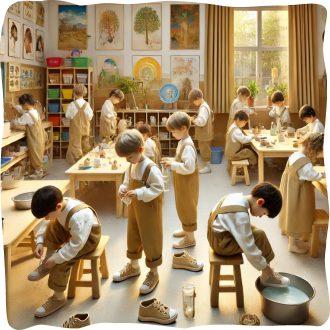In the ever-evolving landscape of education, the focus has largely been on academic achievement, standardized testing, and technological proficiency. However, two crucial components often overlooked are the development of self-help skills and the integration of art into the curriculum. Both these aspects play a pivotal role in nurturing well-rounded, capable individuals who can thrive in diverse environments.
Self-Help Skills: Building Independence and Confidence
Self-help skills refer to the abilities necessary for individuals to take care of their basic needs independently. These skills encompass a range of activities, including personal hygiene, dressing, cooking, cleaning, and managing time and resources effectively.
- Independence and Responsibility: Teaching children self-help skills fosters a sense of independence. When children learn to dress themselves, prepare simple meals, or manage their personal hygiene, they gain confidence in their abilities. This independence also instills a sense of responsibility as children understand that they are capable of taking care of themselves and contributing to their households.
- Practical Life Skills: Incorporating self-help skills into education ensures that students are prepared for real-world challenges. Knowing how to cook, clean, sew, and manage household tasks equips students with essential life skills that are invaluable in adulthood. These practical skills can alleviate the pressures of adult life and enable smoother transitions into independent living.
- Emotional and Social Development: Self-help skills also contribute to emotional and social development. Children who can take care of their own needs are likely to have higher self-esteem and better social interactions. They feel more competent and less dependent on others, which can reduce anxiety and build resilience. Additionally, these skills encourage cooperation and empathy as children learn to help others with tasks and understand the importance of contributing to a community.
Art-Integrated Education: Fostering Creativity and Holistic Growth
Art-integrated education involves incorporating artistic activities such as painting, drawing, music, dance, and drama into the traditional curriculum. This approach enhances the learning experience by making it more engaging, expressive, and multifaceted.
- Enhancing Creativity and Critical Thinking: Art activities encourage creative expression and critical thinking. When students engage in art, they learn to think outside the box, explore different perspectives, and solve problems creatively. These skills are not only essential for artistic endeavors but are also valuable in science, mathematics, and other academic fields.
- Emotional Expression and Mental Health: Art provides a medium for emotional expression, allowing students to convey feelings and experiences that might be difficult to articulate through words. This can be particularly beneficial for children dealing with emotional or psychological challenges. Art therapy has been shown to reduce stress, improve mood, and enhance overall mental well-being.
- Integrating Learning Across Disciplines: Art-integrated education promotes interdisciplinary learning. For instance, students might explore geometric shapes through drawing, understand historical events through drama, or learn scientific concepts through sculpting. This holistic approach reinforces understanding by connecting concepts across various subjects, making learning more meaningful and memorable.
- Encouraging Collaboration and Communication: Many art projects require collaboration, fostering teamwork and communication skills. Students learn to work together, share ideas, and respect different viewpoints. These collaborative experiences are essential in developing social skills and preparing students for future professional environments where teamwork is crucial.
- Cultural Awareness and Appreciation: Through art, students are exposed to diverse cultures and histories, fostering a greater appreciation for global diversity. Learning about different artistic traditions and styles can cultivate empathy and respect for other cultures, promoting a more inclusive and harmonious society.
Combining Self-Help Skills and Art-Integrated Education
The integration of self-help skills and art in education creates a balanced approach to learning that addresses both practical and creative aspects of development. Here’s how these components can be effectively combined:
- Project-Based Learning: Incorporate self-help skills into art projects. For example, students can learn sewing by creating costumes for a school play or develop culinary skills by preparing dishes inspired by their art lessons on different cultures.
- Hands-On Workshops: Organize workshops that teach self-help skills through creative methods. Gardening workshops can teach students about plant care and nutrition, while also involving them in designing and decorating garden spaces.
- Themed Curriculum Units: Develop curriculum units that combine art and self-help skills around central themes. A unit on sustainability could include recycling art projects and lessons on composting and gardening.
Conclusion
Incorporating self-help skills and art-integrated education into the curriculum is essential for developing well-rounded, capable individuals. These approaches foster independence, creativity, emotional resilience, and practical life skills. By emphasizing these components, educators can prepare students not only for academic success but also for the diverse challenges of life beyond the classroom. In doing so, we cultivate a generation of individuals who are not only knowledgeable but also confident, creative, and compassionate.
